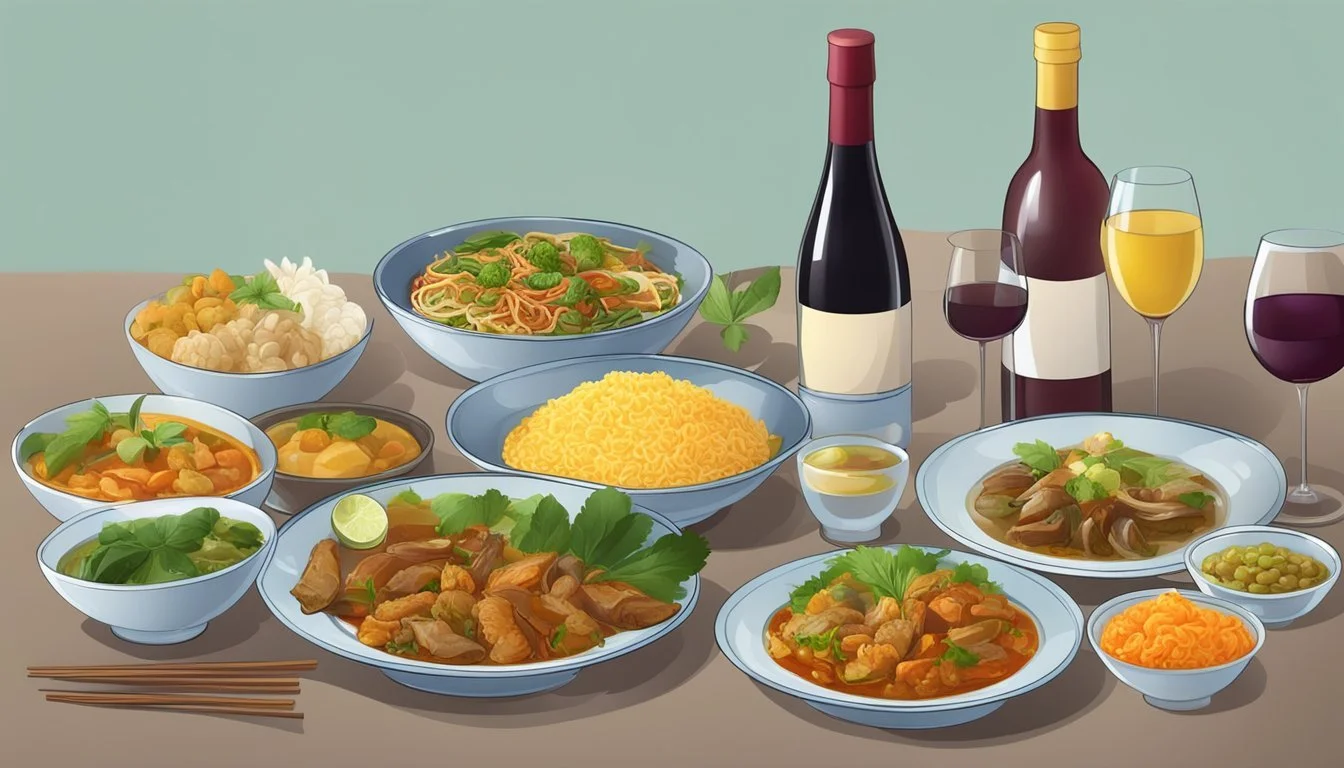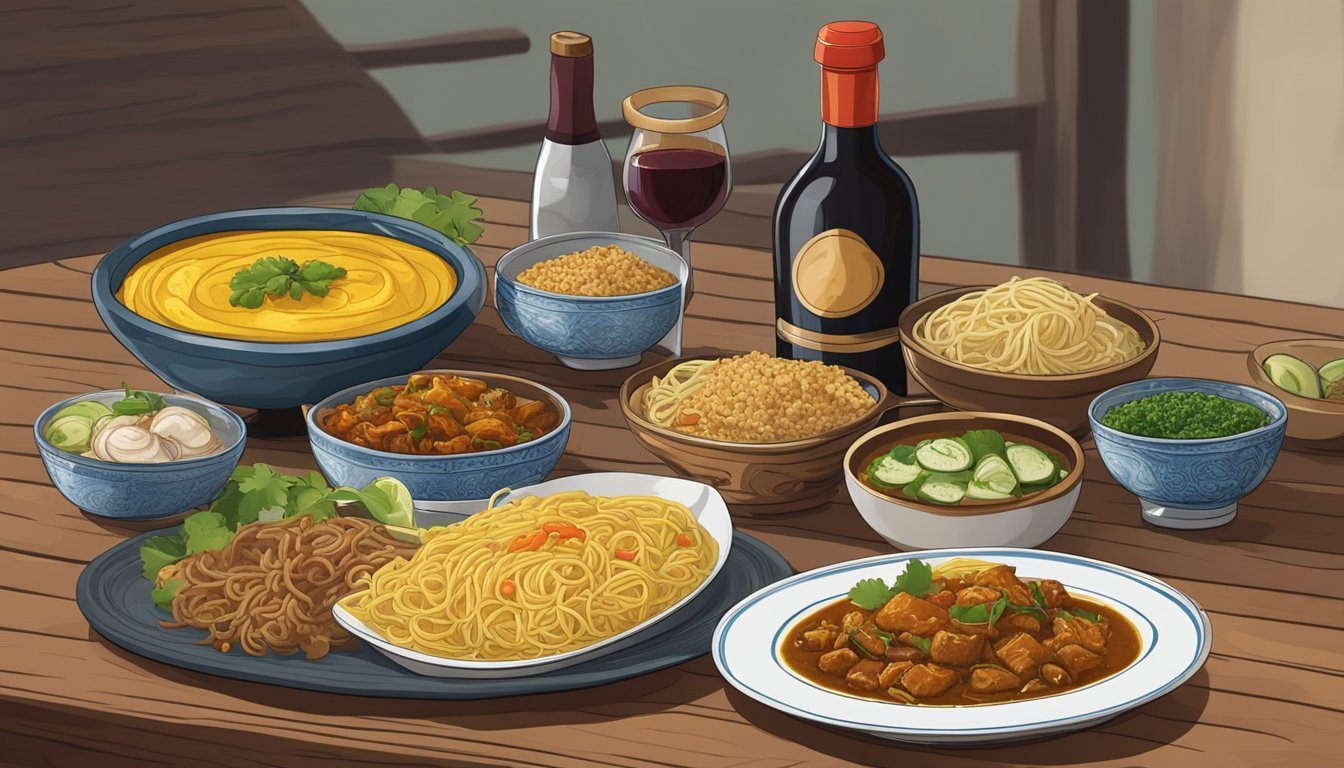What Wine Goes Well with Burmese Food?
Expert Pairing Recommendations
When it comes to pairing wine with Burmese food (What wine goes well with Burmese food?), one must consider the rich tapestry of flavors characteristic of this Southeast Asian cuisine. Burmese dishes often feature a complexity arising from the blend of savory, sour, sweet, and spicy elements, a legacy of the diverse cultural influences ranging from India to China. Traditional ingredients such as lemongrass, fish sauce, tamarind, and a plethora of spices create a unique challenge for finding the perfect wine companion.
Selecting wine to complement Burmese meals requires an appreciation for how the acidity, sweetness, and body of a wine can interact with these bold flavors. A high-acid wine, for instance, can cut through the richness and refresh the palate, while a wine with a hint of sweetness may counterbalance spiciness and harmonize with the overall taste profile.
Careful attention to the dominant notes in a Burmese dish enables one to select wines that enhance rather than conflict with the meal. They offer a supporting role, allowing the complex flavors of the cuisine to shine. Whether dining on mohinga, a rich fish soup, or a salad bursting with fresh herbs and toasted nuts, there is a wine pairing that can elevate the Burmese dining experience.
Understanding Wine Basics
Selecting the appropriate wine to complement Burmese cuisine begins with a grasp of wine fundamentals. The reader will gain an understanding of the various types of wines available and the characteristics that define them.
Wine Varieties
Wine can be broadly categorized into red, white, rosé, sparkling, and dessert wines. Distinct grape varieties and winemaking processes are utilized to produce distinct styles within these categories. For example:
Red Wines: Usually have a presence of tannins and are often aged in oak, which adds complexity. Common red wines include Cabernet Sauvignon, Merlot, and Pinot Noir.
White Wines: Known for their acidity, these wines range from sweet to dry. Chardonnay, Sauvignon Blanc, and Riesling are examples that can vary in sweetness and oak influence.
Rosé Wines: These are produced with the skin contact method, leading to their pink color. They usually have a balance of sweetness and acidity.
Sparkling Wines: Created through a secondary fermentation process, these wines have high acidity. Champagne is a well-known example.
Dessert Wines: Typically sweet, often produced with grapes that have a high sugar concentration.
Wine Characteristics
Understanding wine involves becoming familiar with its defining characteristics:
Tannins: These are compounds present especially in red wines that create a dry, puckering sensation in the mouth.
Acidity: Wines with high acidity are described as 'tart' or 'crisp', essential for the wine's freshness and a good counterbalance to rich food.
Oak: The use of oak barrels in aging can contribute flavors like vanilla, toast, and spice.
Sweetness: The level of residual sugar in wine affects its sweetness. Wines can range from bone-dry to very sweet.
Wines with the right balance of these characteristics can complement the complex flavors of Burmese dishes, which are rich in spices and varying textures.
The Art of Wine Pairing
Pairing wine with Burmese cuisine involves a symphony of flavors that are enhanced when matched with the right wine. The complex spice profiles and textures in Burmese dishes can be elevated by wines that complement or contrast these elements effectively.
Pairing Principles
In the realm of wine pairing, food magazine writers often emphasize the importance of matching the weight and texture of the wine with that of the food. Burmese dishes, known for their rich and diverse flavors, call for wines that balance these tastes without overpowering them. Acidic wines typically cut through the richness, cleans the palate, and can stand up to hearty ingredients. For example:
Spicy Curries: Choose a wine with sweetness like Riesling or Gewürztraminer to balance the heat.
Savory Dishes: A crisp Sauvignon Blanc or Pinot Noir can complement dishes with earthy and umami flavors.
A useful approach is to match the wine with the dominant flavor of the dish—whether it's sweet, savory, spicy, or sour.
Regional Wine Pairings
The concept of 'what grows together goes together' can sometimes extend to Burmese food and regional wines. Although Burma (Myanmar) is not known for wine production, its geographical neighbors produce wines that can harmoniously accompany its cuisine. Here are specific regional pairings:
Thai Influenced Dishes: Wines from neighboring Thailand, such as Monsoon Valley's White Shiraz, a rosé, could pair well with similar flavor profiles in Burmese dishes.
Chinese Influenced Dishes: A lightly oaked Chardonnay from China pairs well with dishes that have a mild sweetness.
As a rule of thumb, wine enthusiasts and food magazine writers often suggest experimenting with different pairings to find a personal favorite, since the diversity of Asian food provides an equally diverse range of possible wine pairings.
Popular Wines for Asian Cuisine
Pairing wine with Asian cuisine hinges on matching the wine's profile to the flavors and intensity of the dishes. Such pairings emphasize balance, considering sweetness, acidity, body, and tannins.
White Wines
Riesling: This white wine is a favorite for its versatility. Dry Riesling matches well with the spice levels found in many Asian dishes due to its pronounced acidity and citrus notes. Sweeter Riesling varieties can complement dishes with a bit of heat, cooling the palate with their sugary finish.
Chardonnay: With its wide range of styles, Chardonnay pairs well with Asian cuisine that includes creamier sauces or coconut-based curries. An unoaked Chardonnay maintains a lighter profile, while an oaked Chardonnay presents a richer body that can stand up to more intense flavors.
Pinot Gris: Offering a light, crisp taste, Pinot Gris works well with dishes that feature delicate flavors such as steamed fish, while its fruitier notes can draw out the best in sweet and mildly spicy dishes (What wine goes well with spicy dishes?).
Sauvignon Blanc: Known for its sharp acidity, this wine is adept at cutting through the richness of fried appetizers and can balance dishes with tangy and herbal elements.
Red Wines
Pinot Noir: A lighter red with lower tannins that plays nicely with a broad spectrum of Asian dishes. Its subtle earthy undertones can enhance the savoriness of umami-rich foods without overwhelming them.
Shiraz: This bolder option can be paired with hearty meat dishes that feature intense flavors, such as Korean BBQ. The peppery notes of a Shiraz resonate with the spices used in marinades and glazes.
Rosé and Sparkling Wines
Rosé: Exhibiting versatility, rosés bring fruit-forward brightness that can cut through the richness of fried foods or harmonize with the sweetness in sauces.
Sparkling Wine: Varieties such as Champagne are celebrated for their ability to cleanse the palate between bites, thanks to their effervescence. They present an especially good match for salty or fatty dishes, often highlighting the complex flavors without overpowering them.
Burmese Food Flavor Profiles
Burmese cuisine offers a complex blend of flavors, often featuring a balance of umami, sour, and herbal notes, grounded in a rich tapestry of local ingredients.
Key Ingredients
The foundation of Burmese cuisine is built upon a variety of key ingredients that impart distinctive flavors:
Lemongrass: A fragrant herb that delivers a zesty lemon flavor with a hint of mint.
Ginger: Adds a warm, spicy kick to dishes.
Kaffir Lime Leaves: Contributing a sharp citrus note that is unmistakably aromatic.
Coriander: Used both fresh and dried, providing a lemony-sour taste and an earthy tone.
Sauces: Essential to Burmese cuisine, with peanut sauce being notably prominent for its rich, creamy texture and flavor.
A range of other ingredients like beef and seafood further expand the flavor profiles of Burmese dishes, allowing for a spectrum of taste experiences influenced by neighboring cuisines, while still maintaining a distinct Burmese identity.
Common Dishes
Burmese cuisine is characterized by an array of common dishes that showcase the careful use of their key ingredients:
Beef Curries: Often slow-cooked, tender beef melds with a combination of spices, sometimes tempered by the sweetness of onions and the boldness of garlic.
Seafood: Fresh seafood is enhanced by a delicate balance of herbs and spices, including the freshness of lemongrass and the depth of ginger, often found in soups (What wine goes well with soups?) and salads.
Traditional dishes like Mohinga Soup, typically comprising fish broth with rice noodles, are clear examples of the harmony achieved with these ingredients. Whether served as street food or as part of a larger feast, these dishes reflect the rich complexity of Burmese cuisine and culture.
Optimal Wine Choices for Burmese Dishes
To complement the dynamic flavors of Burmese cuisine, certain wines can enhance the dining experience. Specifically, wines that balance the intricate spices and varied textures of Burmese dishes should be selected.
Seafood Pairings
For Burmese seafood dishes, (What wine goes well with seafood dishes?) which often carry a delicate yet spicy profile, a wine with a good acid structure is recommended. Off-dry Riesling, with its balance of sweetness and acidity, stands out as an exceptional pairing for such dishes.
Shrimp and lighter seafood: Off-dry Riesling or a vibrant Chenin Blanc.
Chenin Blanc
Dish Wine Recommendation Minted Jalapeno Shrimp Chenin Blanc
Red Meat Pairings
Burmese red meat dishes, ranging from grilled to stewed preparations, typically require wines with both body and fruitiness.
Grilled meats: (What wine goes well with grilled meats?) A fruit-forward Beaujolais or Gamay can be a go-to choice.
Richer stews: A smooth Merlot or a Grenache blend provides the necessary robustness.
Merlot
Dish Wine Recommendation Beef Curry Merlot
Vegetarian Pairings
The earthy and spicy flavors of Burmese vegetarian dishes (What wine goes well with vegetarian dishes?) can be enhanced by a white wine with a strong acidic backbone and a touch of herbaceousness.
Dishes with a soy sauce base: New Zealand Sauvignon Blanc is ideal for its crisp and herby notes.
Sauvignon Blanc
Dish Wine Recommendation Tea Leaf Salad Sauvignon Blanc
Overall, when choosing wines for Burmese cuisine, the aim should be to complement the food's complexity without overwhelming its unique flavor profile.
Advanced Wine Selection Techniques
When selecting wine to complement Burmese cuisine, a thorough understanding of a wine's acidity and tannins, as well as its aging and oak influences, will greatly enhance the pairing experience.
Understanding Acidity and Tannins
Acidity in wine brings out the vibrancy and can balance the rich flavors present in Burmese dishes. Ideally, wines with higher acidity create a refreshing contrast, cutting through the creaminess of coconut-based curries or the fattiness found in dishes such as Burmese chicken curry. On the other hand, tannic wines—which have a dry, astringent quality—should be approached with caution. The tannins found in red wines may clash with certain spices, making medium-tannin wines a safer choice that can complement the complexity of Burmese seasonings without overpowering them.
Aging Potential and Oak Influence
As wines age, their flavors and structure can transform significantly. Burmese food, with its multifaceted flavors ranging from tangy to spicy to umami-rich, often pairs well with oaky and oaked wines that have had time to develop a balance between their pronounced wood-derived flavors and the natural character of the grapes. Wines that have been aged in oak typically acquire hints of vanilla, caramel, and spice, which can echo similar notes in the seasoning of Burmese dishes. Selecting an oaked wine with a good aging potential allows these complementary flavors to surface, but it's essential to consider the level of oakiness and whether the wine's body matches the intensity of the food.
Wine and Asian Spice Interactions
Pairing wine with Burmese or any Asian cuisine involves understanding that the balance between a wine's characteristics and the dish's spices is crucial. Spices can alter the taste of wine, with particular interactions between the wine's acidity, sweetness, and the dish's heat and aromatics.
Managing Spicy Dishes
When dealing with spicy dishes, such as ones featuring Thai green curry, the heat can be intensified by wines that are high in alcohol. In contrast, wines with a touch of sweetness can temper the spiciness and create a more harmonious dining experience. Wines such as Riesling with a slight residual sugar or a fruit-driven Gewürztraminer may work well in managing the heat without overwhelming the palate.
Examples of wines for spicy dishes:
German Riesling: Slightly sweet, lowers the sensation of heat
Gewürztraminer: Floral notes complement spices
Complementing Aromatic Spices
For dishes accentuated with aromatic spices like hoisin, it's important to select wines that complement rather than conflict with the complexity of flavors. A medium-bodied Chardonnay can pair nicely, its creamy texture and subtle oakiness can enhance the sauce's richness without overpowering it.
Examples of wines for aromatic spices:
Chardonnay: Medium-bodied, creamy texture pairs with rich sauces
Pinot Noir: Light-bodied, fruity notes complement diverse spices
It is recommended that drinkers look for wines with balanced acidity and fruitiness to blend seamlessly with the broad spectrum of flavors found in Asian cuisine.
Global Wine Regions and Burmese Food
When pairing wines with the complex and flavorful Burmese cuisine, one must consider the rich tapestry of tastes inherent to the food. The selection process can draw from the established wineries of the Old World to the innovative approaches of the New World's rising stars.
Old World Wineries
The Old World wine regions, which primarily include France, Italy, and Spain, have centuries of winemaking history that offer a diverse palate of options. In France, the delicate notes of a Loire Valley Chenin Blanc can complement a tangy and aromatic Mohinga soup. Italian wines, such as those from Piedmont, also align well with Burmese food. A light Barbera might accompany a dish like Nga Cheik Paung, allowing the subtle flavors of the sticky rice and fish to come through. Spain's offerings, with their robust and traditional flavors, can stand up to the richer curries, such as ones made with beef or lamb, without overpowering the meal's intricate spices.
New World Rising Stars
In contrast, New World wine regions like Chile, Argentina, and Australia's Barossa Valley are establishing a name for themselves in the global wine trade with bold and expressive wines. Chilean Carmenère, with its hint of spiciness, goes hand-in-hand with the complex layers of a Burmese curry. Argentine Malbec with its full-bodied profile and ripe tannins can match the intensity of grilled meat dishes such as Burmese barbecue. The Barossa Valley is known for its Shiraz, which can enhance the experience of a savory and slightly sweet Burmese dish through its fruity and peppery undertones. New World wines are not afraid to set trends and can provide a refreshing counterpoint to the exotic flavors found in Burmese cuisine.
Pairing Wines with Asian Cuisine Beyond Burma
When venturing into the pairing of wines with Asian cuisine, one must consider the diverse flavors and ingredients endemic to regions stretching from Southeast Asia to East Asia. The key is to identify wines that complement the unique spice profiles and cooking techniques of these areas.
Across Southeast Asia
Southeast Asian cuisine is known for its bold flavors, where dishes often balance sweet, sour, spicy, and umami elements. In Thailand, Pad Thai with its tamarind and lime zest pairs exceptionally well with off-dry Riesling, drawing out the dish's citrusy zing. For spicier Thai curries, a chilled Gewürztraminer can tame the heat while enhancing the dish’s aromatic spices.
Singapore's Laksa, a creamy coconut-based soup, requires a wine with a touch of acidity to cut through its richness. A crisp Sauvignon Blanc works well, offering herbaceous notes that echo the soup's spicy warmth. This approach to balance and contrast is essential in matching wines with the multifaceted cuisine of Southeast Asia.
Dish Recommended Wine Pad Thai Off-dry Riesling Thai Curry Gewürztraminer Laksa Sauvignon Blanc
East Asian Influences
Moving to East Asia, each region presents a distinct wine pairing challenge due to the diverse culinary techniques and staple ingredients. Chinese food, with its regional variations, often marries well with wines that can handle a range of flavors from sweet to savory. For instance, the light red fruit notes of a Pinot Noir can complement the richness of Peking duck or pork-based dishes.
Sushi (What wine goes well with sushi?) from Japan invites a clean and delicate wine pairing. A Junmai-type sake provides the traditional match, but for those preferring grape wines, a Chablis with its minerality and unobtrusive apple and citrus flavors can support the sushi's fresh fish without overwhelming it. Meanwhile, the grilled meats of Korean barbecue can stand up to bolder reds. A Syrah, known for its smoky undertones, aligns with the caramelized flavors from the grill.
Cuisine Dish Recommended Wine Chinese Peking Duck Pinot Noir Japanese Sushi Chablis Korean Barbecue Syrah
Asian cuisine, with its complexity and regional distinctiveness, offers a vast playground for wine pairing. The right wine not only complements the food but also heightens the overall dining experience.
Expert Opinions and Resources
In exploring wine pairings with Burmese food, sommeliers and culinary publications provide valuable insights. They outline specific wine recommendations that align well with the unique flavors of Burmese cuisine.
Sommeliers' Recommendations
Rachel Tan, an authority in the wine industry, has made significant contributions with her expertise on pairings. One of her advised pairings is a light Chardonnay to complement the intricate flavors of Burmese dishes like mohinga, a fish broth with rice noodles. A lightly oaked Chardonnay from Burgundy stands out for its compatibility with dim sum, which shares commonalities with Burmese appetizers.
For those who enjoy red wines, the consensus among sommeliers is to opt for something like a Vosne-Romanée Domaine Bertrand & Axelle Machard de Gramont 2017, which pairs exceptionally well with seafood-centered dishes such as simmered king prawns. The balance in this wine is said to highlight the dish's flavors without overpowering them.
Culinary Publications
Michelin Guide Digital underlines the importance of balancing flavors and suggests that wines like Gamay (Beaujolais), known for its lightness and ability to be served slightly chilled, can be the perfect accompaniment to Burmese cuisine.
Guy Nussey of Communications for Journalism also points towards Spanish Garnacha (Grenache), which is full-bodied yet still a good match for the strong, spicy flavors present in many Burmese dishes. Additionally, Nussey notes the growing popularity of rosés, which are versatile enough to pair with a wide range of Asian cuisines, including Burmese.
A common thread in these resources is the emphasis on wines that can stand up to the bold flavors of Burmese food without overwhelming them, creating a harmonious dining experience.
Exploring Unique Wine Styles
In matching the multifaceted flavors of Burmese cuisine, one must seek wines that can stand up to its complexity. This section will explore distinctive wine styles that complement the rich and diverse dishes of Myanmar.
Orange Wines
Orange wines bring a unique profile that can harmonize with Burmese food's layered tastes. These wines are white grapes vinified like reds, where the grape skins remain in contact with the juice for an extended period. This process imparts a deep hue and a robust character, marked by tannins and a spectrum of flavors ranging from sour citrus fruits to savory notes. They often exhibit a complexity that pairs well with dishes like Myanmar chicken curry or eggplant curry, where they offer a refreshing contrast without overpowering the food.
Suggested Pairings:
Traminer: Its aromatic qualities can complement the spices of Burmese curries.
Gewürztraminer: The intense lychee and rose petal notes stand up to hearty flavors.
Dessert Wines
Dessert wines can offer a sweet balance to the savory and sometimes spicy Burmese dishes. Given their sweet profiles, these wines are a natural match for spicy and robust meals, as they provide a counterpoint to the heat and rich flavors. A chilled glass of dessert wine can refresh the palate and act as a delightful counterpart to the complex flavors of traditional Burmese cuisine.
Suggested Pairings:
German Riesling: Its sweetness and acidity can cleanse the palate when eating rich curries.
Muscat (Muscadet): With its floral and fruity notes, it pairs superbly with spicy dishes.
In selecting a wine to accompany a Burmese meal, it's also worth considering wines made from Albariño or Torrontés, as their aromatic profile often carries hints of peach and apricot, accompanied by high acidity which helps cut through the richness of the food. A well-chosen Sancerre, with its crisp and minerally character, may also elevate a dish that includes citrus flavors.
Wine Pairing for Everyday Meals in Burma
In Burma, everyday meals are often a tapestry of flavors influenced by neighboring India, China, and Thailand, ideal for exploration with a variety of wines. Selecting the right wine can enhance the dining experience, complementing the rich and diverse flavors of Burmese cuisine.
Casual Dinners
For casual Burmese dinners featuring dishes like Mohinga, a mildly spiced fish soup often considered the national dish, a light-bodied white wine such as Riesling can pair beautifully. Its crispness cuts through the richness of the soup. Hainanese Chicken Rice, another popular meal, pairs well with wines that have a good balance of acidity and fruitiness. A glass of Pinot Gris or Sauvignon Blanc with its herby notes complements the dish's subtle flavors.
Mohinga and Riesling: A harmonious combination where the wine's acidity complements the mild spices.
Hainanese Chicken Rice and Pinot Gris/Sauvignon Blanc: The wine's crispness respects the dish's delicate flavors.
Special Occasions
Special occasions often call for more robust dishes such as Beef Rendang (What wine goes well with beef rendang?), a slow-cooked beef dish with complex layers of flavor. A robust red wine, like Cabernet Sauvignon, stands up well to the strong flavors and spices without overshadowing the dish.
Beef Rendang and Cabernet Sauvignon: The tannins in the wine work well with the richness of the beef, creating a balanced and enjoyable pairing.
When considering wine and food pairings in Burma, it is important to match the weight and intensity of the food with that of the wine, ensuring one does not overpower the other.
Innovative Wine Pairings
When it comes to the vibrant flavors of Burmese dishes, innovative wine pairings can enhance the dining experience, especially when they subtly complement the complexity of the cuisine's spices and textures.
Fusion Cuisine
In the context of fusion cuisine, specifically where Burmese flavors meet Thai and Cantonese dishes, selecting a wine that mirrors these culinary mergers is key. Thai cuisine often carries a balance of sweet, sour, spicy, and savory tastes, which can be delightfully matched with a Riesling. Its balance of sweetness and acidity complements the bold flavors of such dishes.
For Cantonese dishes, which might involve subtler flavors compared to the robustness of Burmese and Thai food, (What wine goes well with Thai food?) a Chardonnay is recommended. Its versatility makes it a favorable choice, particularly a lightly oaked white Chardonnay from Burgundy, which pairs well with dim sum and other delicate Cantonese preparations.
Trendsetting Wine Varietals
Innovation in wine pairings also pertains to exploring trendsetting varietals, which include the following:
Grenache: This varietal offers a full-bodied experience and matches particularly well with the aromatic and spicy elements found in Burmese cuisine.
Lambrusco: A fruity and bubbly choice; Lambrusco is excellent for dishes that encompass both sweet and salty notes.
Rosés and sparkling wines are setting trends by breaking traditional pairing rules and offering a refreshing counterpoint to the richness of Asian-inspired meals. The lightness of rosés and the effervescence of sparkling wines cut through spiciness and provide a palate cleanse, elevating the meal significantly.
Concluding Remarks on Wine with Burmese Food
Selecting the right wine to complement Burmese food involves considering the rich tapestry of flavors inherent to the cuisine. Burmese dishes, known for their complex and bold blends of savory, sweet, and spicy elements, necessitate careful wine pairing to enhance the dining experience.
Chilean wines, such as Concha y Toro and Casillero del Diablo Viognier, are particularly well-suited for Burmese dishes. The Viognier's aromatic profile with its floral and stone fruit notes can balance the intensity of Burmese spices. Moreover, a wine like Don Melchor, a robust Chilean red, pairs nicely with hearty meat dishes due to its tannic structure and depth of flavor.
When considering white wines, the Limari region in Chile offers varieties that can cut through the richness of oils and nuts often found in Burmese meals. Their bright acidity and crispness provide a refreshing counterpoint to the dense textures.
For those with an appreciation of British beverages, one might note that a British native grape variety would likely struggle against the potent flavors of Burmese food, given the typically lighter and more delicate profiles of British wines.
In contrast, European countries with a long history of wine-making, such as France or Italy, offer a diverse array of wines that can stand up to and complement Asian cuisines, including Burmese.
Lastly, recognizing the growing trend of Asian culinary influences, some Korean wines made from indigenous grapes might also offer an exciting and unconventional pairing for those awarded the Bib Gourmand for their adventurous wine selections with Asian food.
In summary, when pairing wine with Burmese dishes, one should seek out wines that can balance and enhance the myriad of flavors found in this Southeast Asian cuisine. Whether one opts for a versatile Chilean Viognier or a full-bodied red, the key is choosing a wine with the right characteristics to harmonize with the complexity of Burmese food.
















